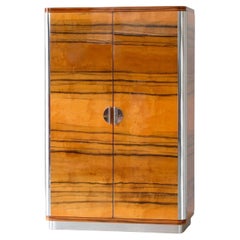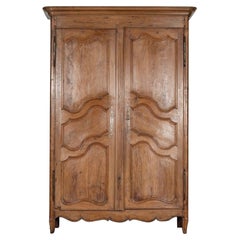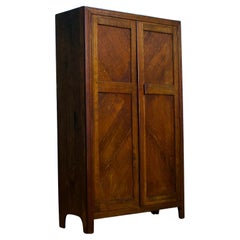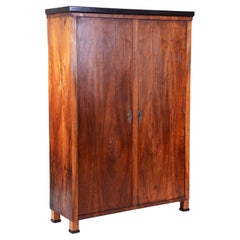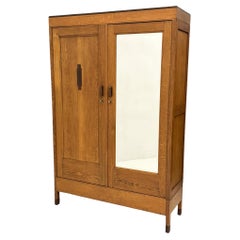Europe - Wardrobes and Armoires
to
129
Height
to
Width
to
Depth
to
1,152
795
916
231
5
234
118
100
38
26
24
22
18
16
14
13
13
7
7
6
6
5
5
138
225
553
236
102
352
66
20
8
29
59
38
101
59
44
12
1
993
384
231
214
208
1,065
271
227
173
100
1,152
944
978
30
29
23
22
14
Item Ships From: Europe
Bespoke Modernist Two-Door Wardrobe, Chromium Finish, Wood Veneer, High-Gloss
By GMD Berlin
Located in Berlin, DE
Custom made three-door wardrobe / armoire, designed and manufactured by GMD Berlin, exclusively presented in our Rudolf Vichr Collection.
These high-quality, handmade furniture in a...
Category
2010s German Modern Europe - Wardrobes and Armoires
Materials
Metal, Chrome
Italian Architectural Wall Unit in Walnut
Located in Waalwijk, NL
Wall unit or wardrobe, walnut, Italy, 1970s
This striking wall unit from the 1970s reflects a bold modernist approach with an architectural appearance. Crafted from rich walnut, the...
Category
1970s Italian Post-Modern Vintage Europe - Wardrobes and Armoires
Materials
Walnut
Large 19thC French Fruitwood Armoire
Located in Staffordshire, GB
circa 1820
Large 19thC French Fruitwood Armoire
sku 965
W168 x D65 x H243cm
Category
19th Century Antique Europe - Wardrobes and Armoires
Materials
Fruitwood
$7,892 Sale Price
20% Off
Vintage Art Deco Oak Compactum Wardrobe, 1930s
Located in South Shields, GB
A beautiful quality oak wardrobe or hall cupboard - circa 1930's
Inside, the cupboard has a pull out clothes rail and shelves
Category
1930s British Art Deco Vintage Europe - Wardrobes and Armoires
Materials
Wood, Oak
Restored Biedermeier Two-Door Wardrobe, Walnut, Revived Polish, Czech, 1830s
Located in Brandys nad Labem, Středočeský kraj
This authentic Biedermeier two-door wardrobe originates from Bohemia from the early 19th century. Its carcass is crafted from solid spruce wood veneered with walnut, giving it a clas...
Category
19th Century Czech Biedermeier Antique Europe - Wardrobes and Armoires
Materials
Lacquer, Wood, Walnut
Fa. Drilling Art Deco Amsterdamse School Armoire or Wardrobe, 1920s
By Fa. Drilling
Located in Amsterdam, NL
Stunning and rare Art Deco Amsterdamse School armoire or wardrobe.
Design by Fa. Drilling Amsterdam.
Striking Dutch design from the 1920s.
Solid oak base with original solid macassar...
Category
1920s Dutch Art Deco Vintage Europe - Wardrobes and Armoires
Materials
Mirror, Macassar, Oak
Armoire Solid Natural Oak, France, 1940s
Located in Kaštel Sućurac, Splitsko-dalmatinska županija
Standing with monastic presence, this tall armoire in natural oak bears a façade of geometric rigor and quiet monumentality. Six raised diamond-point panels animate the surface with ...
Category
Mid-20th Century French Mid-Century Modern Europe - Wardrobes and Armoires
Materials
Oak
20th Italian Wardrobe walnut four doors mirror
Located in Buggiano, IT
Italian wardrobe with 4 doors, in solid walnut, rusticated on the sides and on the front.
It can be completely disassembled. Inside, in the left part there is a chest of drawers wit...
Category
Late 20th Century Italian Rustic Europe - Wardrobes and Armoires
Materials
Walnut, Fir
$2,198 Sale Price
61% Off
Italian Art Deco 1940s Wardrobe
Located in Milan, IT
Splendid Italian 1940s Art Deco wardrobe.
Category
1940s Italian Art Deco Vintage Europe - Wardrobes and Armoires
Materials
Wood
Bauhaus Functionalism Chrome Wardrobe by Rudolf Vichr - 1930s
By Rudolf Vichr
Located in Praha, CZ
- 1930s, Czechoslovakia
- maker: Rudolf Vichr Prag
- green color right according to R. Vichr sample book colors (see the pictures)
- hand polished, high shine
- interior refurbished
...
Category
1930s Czech Bauhaus Vintage Europe - Wardrobes and Armoires
Materials
Chrome
Josef Hoffmann Jugendstil Wiener Werkstaette Art Nouveau Coat Hook, Re-Edition
By Woka Lamps, Wiener Werkstätte, Josef Hoffmann
Located in Vienna, AT
Very elegant handmade coat-hook. Literature: Waltraud Neuwirth, Wiener Werkstaette – Avant Garde Art Deco, Industrial Design, 1985 Vienna p. 49.
Different hooks are available see pi...
Category
2010s Austrian Jugendstil Europe - Wardrobes and Armoires
Materials
Brass
Room '56 bedroom closet for Dico, 1950's
Located in Steenwijk, NL
This refined wooden bedroom closet was designed for the former and renowned Dutch bed manufacturer DICO in the 1950's. It was part of the 'Kamer 56' (tr...
Category
1950s Dutch Mid-Century Modern Vintage Europe - Wardrobes and Armoires
Materials
Metal
Cloakroom / Workshop cabinet - Armoire - industrial - vintage - France
Located in Beuzevillette, FR
Former workshop changing room for employees of the Compagnie Française de Raffinage, CFR, and more particularly for the Normandy refineries in France.
Still has the Normandy refiner...
Category
Mid-20th Century French Industrial Europe - Wardrobes and Armoires
Materials
Wood
Italian closet by Giovanni Gariboldi in lacquered wood and glass
By Giovanni Gariboldi
Located in Milano, IT
Step into a bygone era of timeless elegance with the Italian wardrobe cabinet by the master craftsman Giovanni Gariboldi, a true masterpiece f...
Category
1950s Italian Mid-Century Modern Vintage Europe - Wardrobes and Armoires
Materials
Brass
$11,341 Sale Price
20% Off
Mid-Century Wardrobe Highboy Dresser Danish Teak, G. Renkel for Rego
By Günter Renkel
Located in Saarbruecken, DE
Mid-Century Wardrobe Danish Teak.
Günther Renkel for Rego Moebel, Göttingen Germany, 1960s.
perfect vintage condition. shelves and coat hanger.
match...
Category
1960s German Mid-Century Modern Vintage Europe - Wardrobes and Armoires
Materials
Teak
1920s Venetian Baroque Wardrobe Carved Walnut, Attributed Testolini & Salviati
By Testolini & Salviati
Located in Vigonza, Padua
Venetian Baroque exceptional wardrobe, in hand-carved walnut and burl walnut fillet inlay of the period 1920s, Testolini & Salviati attributed; only we just polished it with wax.
Me...
Category
1920s Italian Baroque Revival Vintage Europe - Wardrobes and Armoires
Materials
Walnut, Burl
Libellula Shoe Cabinet by Chie Mihara
By Extroverso
Located in Milan, IT
This walnut wood shoe cabinet features two doors decorated with two large, white dragonflies and brass handles. The sides are made of glass and Vienn...
Category
2010s Italian Europe - Wardrobes and Armoires
Materials
Metal
$23,891 / item
Midcentury Small Wardrobe from Up Zavody, 1970
By Up Závody
Located in Żory, PL
This ash & mahogany wardrobe was manufactured in 1970 by UP Zavody in Czechoslovakia. It has 4 shelves and 2 drawers. The wardrobe is preserved in its original, very good condition.
...
Category
Mid-20th Century Mid-Century Modern Europe - Wardrobes and Armoires
Materials
Wood
19th Century French Louis XVI Mahogany and Gilt Bronze wardrobe
Located in Cheshire, GB
19th Century French Louis XVI Mahogany and Gilt Bronze Armoire, the dome top above a large central bevelled mirror door flanked by two narrow well-figure panelled doors. Opening to r...
Category
Late 19th Century French Antique Europe - Wardrobes and Armoires
Materials
Wood
Modernist Three Door Wardrobe, Chrome Plated Metal and Walnut Veneer, circa 1930
By Hermann John Hagemann
Located in Berlin, DE
Modernist Wardrobe designed by Hermann John Hagemann and manufactured by Thonet or Mücke-Melder, circa 1930. The wardrobe is made of chrome plated tubular steel and walnut veneered w...
Category
1930s Austrian Bauhaus Vintage Europe - Wardrobes and Armoires
Materials
Metal, Chrome
Renaissance Palace Wardrobe with Perspectival Views
Located in Saint-Ouen, FR
A rare carved walnut wardrobe opening with four door-leaves and two drawers in the lower part. The doors bear architectural views in low reliefs, fluted pilasters and Ionic capitals.
Upper Body
Two door-leaves with carved architectural perspectives open the wardrobe framed by three fluted pilasters with Ionic capitals.
Each door-leaf depict two semi-circular arcades whose cornice and base shows a central vanishing point. Likewise the pavement’s lines act for the artisan as a way to create depth. The vaulting instead leads us to think the vanishing point has to be situated where the handle is, between the two complementaries reliefs.
The elegant moulded belt hides an internal secret space, accessible through a moveable plank in the upper body.
Lower Body
Two door-leaves identical to those of the upper body framed by three fluted pilasters with Doric capitals. The base of the wardrobe opens with two large drawers.
The sides also bear panels depicting architectural perspectives. The external pilasters share their Ionic capital with the facade’s pilasters. Thus we can observe on the wardrobe’s sides the capital’s lateral parts with the elegant volute specific to the Ionic order.
This palace wardrobe is topped by an overlapping cornice standing on three consoles for the facade and two consoles on each sides. Placed right above the pilasters each console are adorned by fully expanded leaves.
During the 15th century a major interest for architecture and perspective studies arises and influences patrons tastes. The work of great theorists such as Leon Battista Alberti...
Category
16th Century Italian Renaissance Antique Europe - Wardrobes and Armoires
Materials
Walnut
Customized Modernist Four-Door Wardrobe, High-Gloss Lacquer, Handcrafted Wood
By GMD Berlin, Rudolf Vichr
Located in Berlin, DE
Customized four-door wardrobe, manufactured by GMD Berlin, exclusively presented in our Rudolf Vichr Collection.
These high-quality, handmade furniture in a classic modern timeless ...
Category
2010s German Modern Europe - Wardrobes and Armoires
Materials
Metal, Chrome
Fornasetti Curved Cabinet Coromandel Hand Colored Wood Special Edition
By Fornasetti
Located in MILANO, IT
The curved cabinet shape was designed by Barnaba Fornasetti in 2003 and now it can be considered one of the most iconic pieces of furniture in the Itali...
Category
21st Century and Contemporary Italian Modern Europe - Wardrobes and Armoires
Materials
Wood
Mid century birch wardrobe by Oscar Nilsson Nordiska Kompaniet
By Oscar Nilsson
Located in Debenham, Suffolk
Mid century birch wardrobe by Oscar Nilsson for nordiska kompaniet circa 1939.
We are pleased to offer this fitted wardrobe which is an early piece in the scandinavian modern furnit...
Category
Mid-20th Century Swedish Mid-Century Modern Europe - Wardrobes and Armoires
Materials
Birch
Art Deco Cloud Figured Walnut Wardrobe, English, c1930
Located in Devon, England
For your consideration is this fabulously styled Art Deco wardrobe dating to the 1930's. Small and well proportioned this wardrobe has stunning Walnut grain with book paged veneers w...
Category
Mid-20th Century English Art Deco Europe - Wardrobes and Armoires
Materials
Walnut
1930s Rare Bauhaus Wardrobe by Hynek Gottwald, Czechoslovakia
By Hynek Gottwald
Located in Praha, CZ
- Good original condition with some signs of use
- Chrome plated tubular legs with signs of use
- This item will be shipped dismantled outside of EU.
- Wood renuver oil
- Cleaned
Category
1930s Czech Bauhaus Vintage Europe - Wardrobes and Armoires
Materials
Chrome
French Renaissance Revival Library 19th Century - France - Henri II style
Located in Beuzevillette, FR
Bookcase in carved wood in Henri II style or Renaissance style with inspirations from Greek and Roman architecture. A large drawer in the lower part, two mesh and molded doors, with ...
Category
19th Century French Renaissance Revival Antique Europe - Wardrobes and Armoires
Materials
Wood
Original Vintage Large Industrial Oak Wood File Cabinet with Multiple Drawers
Located in Warszawa, Mazowieckie
This large, industrial catalog cabinet with multiple flat drawers was made during the 1930s and comes from Artist's Atelie. It is made of high-qual...
Category
1930s European Industrial Vintage Europe - Wardrobes and Armoires
Materials
Brass
$7,083 Sale Price
20% Off
1930s Bauhaus Wardrobe in Walnut, Czechoslovakia
Located in Praha, CZ
- Item has been carefully refurbished and finished with renover oil
- Chrome plated legs in good original condition with some signs of use
Category
1930s Czech Bauhaus Vintage Europe - Wardrobes and Armoires
Materials
Wood, Walnut
Paolo Buffa Large Highboard or Wardrobe in Chestnut 1940s
By Paolo Buffa
Located in Waalwijk, NL
Paolo Buffa, wardrobe or large cabinet, chestnut, Italy, 1940s
This rare wardrobe exudes subtle decorative charm and is the work of the talented Italian designer and architect Paolo...
Category
1940s Italian Mid-Century Modern Vintage Europe - Wardrobes and Armoires
Materials
Chestnut
Vintage 3-door wardrobe made in the 60s
Located in Breda, NB
Vintage 3-door wardrobe made in the 60s.
This vintage 3-door wardrobe from the 1960s combines timeless design with practical functionality. Offering generous storage behind its thre...
Category
1960s Scandinavian Modern Vintage Europe - Wardrobes and Armoires
Materials
Wood
Early 20th Century Whitewashed Massive Baltic Pine Two-Door Armoire
Located in Barntrup, DE
This beautiful and massive early 20th-century Baltic armoire features paneled doors and two pull-out drawers below, three massive turned column pilasters, and two half-columns on each door. The exterior front side has a whitewashed finish. Inside, the pine remains in its raw color. The right side is equipped with two drawers, in both sides, there are original wooden clothes hangers...
Category
Early 20th Century Latvian Art Nouveau Europe - Wardrobes and Armoires
Materials
Metal
Large 18th Century French Painted Pine Armoire
Located in Staffordshire, GB
circa 1780
Large 18th century French painted pine armoire
sku 1405
Measures : W174 x D65 x H190 cm.
Category
18th Century Antique Europe - Wardrobes and Armoires
Materials
Pine
$11,882 Sale Price
20% Off
Bamboo/Rattan and Brass Wardrobe by Dal Vera, Italy, 1970s
By Franca Helg, Antonio Piva and Franco Albini, Dal Vera, Vittorio Bonacina
Located in Kaštel Sućurac, Splitsko-dalmatinska županija
A study in disciplined warmth, this Italian wardrobe by Dal Vera reveals a language of measured proportion and tactile serenity. Crafted in the 1960s, its architecture embodies the m...
Category
1970s Italian Mid-Century Modern Vintage Europe - Wardrobes and Armoires
Materials
Brass
19th Century Fine Biedermeier Walnut Armoire. Vienna, c. 1825.
Located in Vienna, AT
Hello,
We would like to offer you this truly exquisite, early Biedermeier walnut armoire. The piece was made in Vienna circa 1825.
Viennese Biedermeier is distinguished by their sop...
Category
Early 19th Century Austrian Biedermeier Antique Europe - Wardrobes and Armoires
Materials
Walnut
Adolf Loos for Knize Taylorshop, Coathook Re-Edition by Woka Lamps Vienna
By Woka Lamps, Adolf Loos
Located in Vienna, AT
Designed for the Knize Taylor-shop in Vienna, Paris and Berlin. A three-hole, or a four-hole version is avaliable.
Category
2010s Austrian Jugendstil Europe - Wardrobes and Armoires
Materials
Brass
Antique Wardrobe, English, Walnut, Compactum, R. James Gloucester, circa 1900
Located in Hele, Devon, GB
This is an antique wardrobe in English walnut, a compactum bearing the cabinet makers name plate to the rear reading 'R. James Art Cabinet Maker & Carpet Factor, 14 Northgate St. Glo...
Category
19th Century English Late Victorian Antique Europe - Wardrobes and Armoires
Materials
Walnut
Bespoke Modernist Three-Door Wardrobe, Chromium Finish, Wood Veneer, High-Gloss
By GMD Berlin
Located in Berlin, DE
Custom made three-door wardrobe / armoire, designed and manufactured by GMD Berlin, exclusively presented in our Rudolf Vichr Collection.
These high-quality, handmade furniture in a...
Category
2010s German Modern Europe - Wardrobes and Armoires
Materials
Metal, Chrome
Carabottino cabinet, in canaletto walnut, by Cara Davide for Medulum
By Cara e Davide
Located in Meolo, Venezia
Carabottino is a collection made of a clever play of textures and
transparencies, that makes these objects the centerpiece of any environment. A
storage unit, a mirror or a table that establishes a dialogue between inside and
outside.
A wooden grating in a two-dimensional form traditionally made with wooden
slats, carabottino is considered to be an accessory element of relative
importance, similar to window and door...
Category
2010s Italian Modern Europe - Wardrobes and Armoires
Materials
Wood, Walnut
$6,368 Sale Price / item
20% Off
Large English Oak Haberdashery Cabinet
Located in Staffordshire, GB
circa 1930
Large English Oak Haberdashery Cabinet, divides into two pieces.
sku 1254
W182 x D52 x H198cm
Category
Early 20th Century Europe - Wardrobes and Armoires
Materials
Oak
$15,186 Sale Price
20% Off
Six-door closet 1950s 1960s
By Non-Standard Furniture and Lighting
Located in Milano, IT
Elegant vintage six-door closet, restored in our workshops, with exotic wood veneer, interior with brass hangers, shelves, drawers and storage compartments with glass front.
Category
1950s Italian Mid-Century Modern Vintage Europe - Wardrobes and Armoires
Materials
Brass
19th Century Biedermeier Walnut Wardrobe from Germany
Located in Darmstadt, DE
Very nice simple wardrobe from the time of the Biedermeier. Made of solid walnut. The cabinet has very beautiful walnut wood that leaves a great impres...
Category
Early 19th Century Biedermeier Antique Europe - Wardrobes and Armoires
Materials
Pine, Walnut
$8,979 Sale Price
20% Off
Early 18th Century German Baroque Armoire in Walnut Frankfurt Wellenschrank
Located in Kleinfischlingen, DE
Early 18th Century German Baroque Frankfurt Armoire in Walnut
This exceptional Baroque armoire, made in Frankfurt circa 1700, is crafted from walnut, walnut burl, and walnut root v...
Category
Early 1700s German Baroque Antique Europe - Wardrobes and Armoires
Materials
Wood, Walnut
Important Renaissance Cabinet from Lyon 'France' with a Decor of Perspectives
Located in Saint-Ouen, FR
As soon as 1540 France's second Renaissance is in the making, intimately linked to the rediscovery of the Antique world. The development of the printing and engraving industry allows the spread of artworks and models in many cities and countries. The Italian influence can be perceived in every artistic field. While the French king entrust the most talented Italian artists with major projects such as Il Rosso or Primaticcio in Fontainebleau, French artists also travel to Italy to form themselves to this new style. In Italy they get acquainted with the work of Leo Battista Alberti the first to theorize perspective (De Pictura, 1435-36) and architecture (De re oedificatoria, 1541). Those two publications would have a revolutionary impact on arts.
Furniture is marked by the work of the most famous Italian architects of the time as well as French architects. Indeed Philibert de l'Orme competes with Alberti and by the end of his life publishes several treaties including one devoted to a theory of architecture (1567). Unfortunately he would not live to complete the second volume. In this treaty he expresses his interest for mathematical norms applied to architecture, copied from the Antique. His journeys in Italy allowed him to accumulate the most sophisticated references. Jean Bullant, another architect of great talent also theorizes his practice. He establishes rules characterizing Greco-Roman art staying faithful to Vitruvius.
Following this new inspiration the structure of furniture evolves. From then on appear columns, capitals, cornices, friezes and architraves. The ornamentation uses this inspiration as well with egg-and-dart, palm leaf and rose adorning the most beautiful pieces.
In Lyon, crossroad where meet merchants from everywhere those new experiments are welcomed. Lyon florishing printing industry allows the spreading of models and treaties essential to the artist's work. Thus the first publication of Vitruvius' De Architectura in France would be printed in Lyon in 1532.
Artists from Lyon rediscover and familiarize themselves with the Antique knowledge very early. They adopt those new ideas and use them in their own creations. Lyon cabinet-makers re interpret Antique architecture and Italian Renaissance palaces to give their pieces a pure and harmonious architectural structure. Grooved pilasters are particularly favored. They are topped by capitals of diverse orders always respecting the sequencing with simpler ones for the lower levels and the richest ones on the higher levels. As for the ornamentation, one of the great distinctiveness of Lyon workshops remains the architectural perspective illusions, drawing inspiration from Tuscany.
True masterpiece of the Second French Renaissance this important cabinet illustrates Lyon workshops' taste for fine Italian architecture inspired by Antiquity. An architectural perspective of great quality is treated in symmetry on each panel.
This two-bodied cabinet without recess stands on four rectangular feet. The base comprises a molding, a palm leaf frieze and is bordered by a braid.
The lower body is divided by three grooved pilasters with Tuscan capitals framing two door-leaves. The two panels are encircled by a moudled frame with palm leaves. They are finely carved with a decor of fantasized architecture depicting an Italian Renaissance palace erected symmetrically on each side of a grooved pilaster. On the ground floor a door opens through a stilted arch while the stories are opened with mullioned windows, dormers and occuli. Two large pegged-boss cladded pillars support the entablature enriched by a palm leaf frieze upon which stands an arch whose coffered intrados is centred by a rose. Behind this arch a pyramid appears, standing in front of a second facade with a window topped by a broken curvilinear pediment under a cul-de-four with a shell.
The checker flooring gives depth to the low-reliefs creating vanishing points structuring the panels and guiding the eye of the observer.
A thin laurel braid highlights the belt of the cabinet where are located two drawers. Their facades are adorned by palm leaves in hoops.
The upper body is encircled with palm leaves. The same ternary division as in the lower body appears. However, the pilasters are topped by Ionic capitals with volutes and egg-and-dart. The door-leaves are framed with flowers. On the panels the artist has designed another architectural decor. On the foreground open two arches on top of grooved pilasters with rectangular capitals adorned with palm leaves. The arches are enriched with braids and the coffered intrados bears a decor of roses. The spandrels also bear a flower decor. In the background another arcature hosts a fluted grooved column topped with double basket acanthus capital, characteristic of Corinthian order. The triangular pediment is interrupted by a choux bourguignon.
A large cornice crowns the cabinet. It stands on pilasters and forms an entablature comprising a palm leaf frieze and an egg-and-dart, triglyph and palm leaf cornice.
The cabinet's sides have also been carefully considered. The lower body's panels are enriched with an arch rising above a broken pediment portico hosting a twisted column. Flowers garnish the spandrels. An architectural facade completes the decor. The upper body's panels present two arches supported by a facade opened with dormers and mullioned windows as well as cartouches (one bears the inscription 1580 dating the cabinet) suggesting the interior of an Italian Renaissance palace, confirmed by the chandeliers. The flooring leads our gaze to a second arch with a broken curvilinear pediment where stands a flower vase. This arch opens onto a perspective of another facade along a road.
Inside the cabinet, on the lower body door-leaves appear two designs. On the right door is depicted a Crucifixion. Saint Mary and Saint John flank the Christ on the cross. In the bottom part is inscribed « Dure uiator abis nihil haec spectacula curas / Pendenti cum sis unica cura Deo. / Tota suo moriente dolet natura Magistro. / Nil qui solus eras caussa dolenda doles. ». The signature [Christoff Swartz Monachiensis pinx[it] / Ioa[nnes] Sadeler sculp[it]] tells us it was made by Johan Sadeler I (1550-1600) after Christoph Schwartz (1548-1592). This engraving belongs to an ensemble depicting the Passion of Christ Johan Sadeler executed in 1589 after an altar piece painted by Christoph Schwartz for the private chapel of Renée of Loraine, wife of Duke William V of Bavaria. This altar piece made of nine copper panels has been destroyed during the 19th century. The Crucifixion panel once in the centre of the altar piece is the only one that survived and is today kept in Munich's Alte Pinakothek.
On the left door appears Saint Francis receiving the stigmata. The inscription says : « Signastidomine Servum Tuum. Franciscum. Signis Redemptionis Nostrae ».
This Renaissance cabinet with an architectural decor appearing as much in the structure faithful to Antique rules...
Category
16th Century European Renaissance Antique Europe - Wardrobes and Armoires
Materials
Walnut
Art Deco wrouth iron wardrobe with mirror and light
Located in Schöfflisdorf, CH
Art Deco wroth iron wardrobe with mirror
Category
1930s French Art Deco Vintage Europe - Wardrobes and Armoires
Materials
Wrought Iron
Large 19th Century Country House Wardrobe
Located in Leamington Spa, Warwickshire
Large late 19th century English painted country house wardrobe with great storage and fully dismantles for delivery. 1880.
Code: 8823
Dimensions:
W: 90.5" (229.9 cm)
H: 84" (213.4...
Category
19th Century English Victorian Antique Europe - Wardrobes and Armoires
Materials
Mahogany
Wardrobe, France, around 1890. Antique.
Located in Chorzów, PL
An antique wardrobe from the end of the 19th century. Furniture in very good condition.
Dimensions: height 258 cm / width 159 cm / depth. 50 cm
Category
Late 19th Century French Louis Philippe Antique Europe - Wardrobes and Armoires
Materials
Wood
Antique wardrobe, France, around 1870.
Located in Chorzów, PL
Antique wardrobe from the 19th centuries. Furniture in very good condition.
Dimensions: height 260 cm / width 112 cm / depth. 57 cm
Category
Mid-19th Century Unknown Louis Philippe Antique Europe - Wardrobes and Armoires
Materials
Wood
Italian Art Deco Parchment Wardrobe
Located in London, GB
A large five door Art Deco parchment and maplewood wardrobe.
Circa 1940's, Italy.
The wardrobe features numerous internal fittings including dra...
Category
1940s Italian Art Deco Vintage Europe - Wardrobes and Armoires
Materials
Maple, Parchment Paper
Large Italian Art Deco Wardrobe or Highboard in Walnut 1940s
Located in Waalwijk, NL
Wardrobe or highboard, walnut, wood, Italy, 1940s
This large, elegant sideboard embodies the refined aesthetic sensibilities characteristic of the Italian Art Deco period of the 19...
Category
1940s Italian Art Deco Vintage Europe - Wardrobes and Armoires
Materials
Walnut
Antique Gentleman's Wardrobe, Walnut, Compactum, Waring and Gillow, Victorian
Located in Hele, Devon, GB
This is an antique gentleman's wardrobe. An English, walnut compactum cupboard by Waring & Gillow, dating to the late Victorian period, circa 1900.
...
Category
Late 19th Century British Antique Europe - Wardrobes and Armoires
Materials
Walnut
Luciano Frigerio Mid-Century Modern Italian Brass and Walnut Wardrobe, 1970s
By Luciano Frigerio
Located in Puglia, Puglia
Designed by Luciano Frigerio, wardrobe with eleven doors in brass and walnut wood, Macassar ebony is a precious essence that is widely used in cabinet making, fine carpentry, turning...
Category
1970s Italian Mid-Century Modern Vintage Europe - Wardrobes and Armoires
Materials
Brass
$14,886 Sale Price
30% Off
Up to 2 Midcentury Brass Double Wall Hooks by Herta Baller, Austria, 1950s
By Herta Baller
Located in Vienna, AT
Up to two beautiful Austrian modernist brass wall hooks, executed in the 1950s by Hertha Baller, Austria. Made of black finished and partly polished brass, very solid, in good condit...
Category
Mid-20th Century Austrian Mid-Century Modern Europe - Wardrobes and Armoires
Materials
Brass
Unique wardrobe, France, around 1880.
Located in Chorzów, PL
Unique wardrobe, France, around 1880.
Very good condition.
wood: walnut
dimensions: height 240 cm width 130 cm depth 51 cm
Category
Late 19th Century French Belle Époque Antique Europe - Wardrobes and Armoires
Materials
Wood, Walnut
Custom Made Art Deco Inspired Cupid Wardrobe Wood, Suede and Bronze Handles
By Casa Botelho
Located in London, GB
Indulge in the ultimate wardrobe experience with the all-new Cupid Wardrobe II! This sophisticated masterpiece offers a wider and larger storage capacit...
Category
21st Century and Contemporary British Art Deco Europe - Wardrobes and Armoires
Materials
Ultrasuede, Hardwood, Beech
19thC Large French Ebonised Mirrored Armoire
Located in Staffordshire, GB
Circa 1880.
19thC large French ebonised mirrored armoire. With adjustable shelves, drawer, original hardware & key.
Sourced from the South of Fra...
Category
Late 19th Century French Antique Europe - Wardrobes and Armoires
Materials
Pine
$5,705 Sale Price
34% Off
Bespoke Modernist Three-Door Wardrobe, Chromium Finish, High-Gloss Lacquer
By GMD Berlin
Located in Berlin, DE
Custom made three-door wardrobe / armoire, designed and manufactured by GMD Berlin, exclusively presented in our Rudolf Vichr Collection.
These high-quality, handmade furniture in a...
Category
2010s German Modern Europe - Wardrobes and Armoires
Materials
Metal, Chrome
Art Nouveau wardrobe from the early 20th century, France.
Located in Chorzów, PL
Antique Art Nouveau wardrobe from around 1920, France.
Furniture in very good condition, after professional renovation.
Dimensions: height 250 cm / width 118 cm / depth 66 cm
Category
Early 20th Century French Art Nouveau Europe - Wardrobes and Armoires
Materials
Glass, Mirror, Wood
Large Vintage Industrial Metal Factory Three Doors Cabinet, 1950s
Located in Warszawa, Mazowieckie
This industrial, metal factory cabinet was produced during the 1950s. The wardrobe has three doors with ventilation openings. There are hangers f...
Category
1950s Industrial Vintage Europe - Wardrobes and Armoires
Materials
Metal
$2,830 Sale Price
20% Off
Antique industrial storage locker 1910
Located in Meulebeke, BE
Made around 1910 in France, this locker has three compartments to store all your belongings. The locker has a dark green-grey colour that goes perfectly with any style.
The locker a...
Category
1910s French Industrial Vintage Europe - Wardrobes and Armoires
Materials
Metal
Recently Viewed
View AllMore Ways To Browse
Italian Armadio
Travel Armoire
Triple Antique Wardrobe
Triple Armoire
Used Mirrored Closet Doors
Venetian Armoire
17th Century French Armoire
Vintage Bamboo Armoire
Antique Belgian Wardrobe
Antique Brass Wardrobe Rail
Antique Rosewood Armoire
Antique Swedish Armoire
Armoire Carved Birds
Art Deco Tallboy
Brass Clothes Rail
Break Down Armoire
Cherry Wood Wardrobe France
Cherrywood Wardrobe
